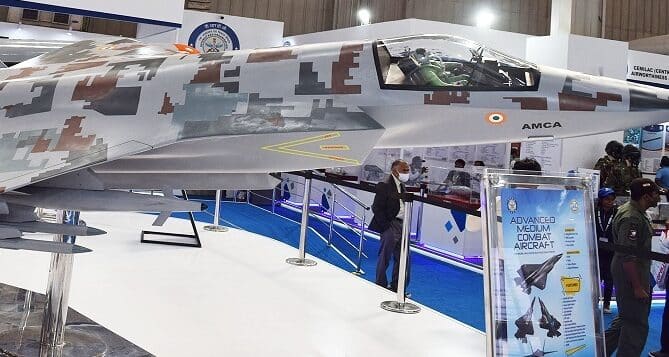Aviation
The AMCA fifth generation fighter made in India will be the most affordable among its competitors?

In an era of rapid technological advances and rising global security issues, India is prepared to change the landscape of aerial warfare with its indigenously developed Advanced Medium Combat Aircraft (AMCA). The AMCA program is a remarkable feat of engineering and creativity that has the prospect of altering the future of military aviation by combining cutting-edge technology with a strategic focus on cost-effectiveness.
The AMCA (Advanced Medium Combat Aircraft) project is an ambitious effort that aims to create cutting-edge fighter aircraft capable of leading modern combat. This aircraft will combine the most recent improvements in vital areas including avionics, stealth technology, sensors, and weapon systems.
While the project admits the incorporation of expensive and sophisticated equipment, which naturally leads to higher prices as compared to its fourth-generation predecessors, there is optimism that these initial costs will stabilize with time. There are also plans for future enhancements, with the MKIII version of the AMCA projected to be completed in 2035.
This cost-effectiveness is supposed to be achieved by a strategic approach that capitalizes on indigenous competencies and resources. According to the AMCA project, around 80% of the aircraft’s components, including its engines, will be manufactured domestically.
Utilizing local production has the ability to lessen reliance on foreign suppliers, which is one of its most important benefits. Long-term cost reductions could result from this decrease in dependency on the outside world. India wants to achieve economic sales, reduce manufacturing costs, and assure the long-term viability of the project by building a strong domestic industrial base for the AMCA.
This strategy offers a variety of advantages. It primarily increases India’s capacity for self-sufficiency and lessens its vulnerability to supply chain interruptions that may result from geopolitical or economic issues. Furthermore, bolstering local manufacturing capacity promotes the development of a skilled labor force, supports technical advancement, and stimulates economic expansion. Additionally, India may position itself as a major player in the global defense market by developing a robust defense industrial base, potentially generating revenue through exports of the AMCA and related technologies.
Most of the technology being developed or adopted in India will make aeroplanes less expensive than other aircraft.
AMCA project represents a forward-looking strategy that prioritizes both cutting-edge technological capabilities and long-term economic sustainability. By focusing on indigenous production and reducing dependence on foreign suppliers, India aims to not only develop a formidable fighter aircraft but also enhance its strategic autonomy and economic resilience on the global stage. This comprehensive approach underscores the intricate interplay between defense, technology, and economic considerations in shaping a nation’s future.

Aviation
Boeing, Antonov to Collaborate on Defense Projects

– MOU represents Boeing’s commitment to work with Ukrainian industry
– Includes exploring opportunities for collaborating on in-country support of Unmanned Aerial Systems
A Memorandum of Understanding was signed today by Boeing and Antonov Company to investigate potential collaboration on defense-related projects.
“We’re happy to keep collaborating with the Antonov Company to help Ukraine’s economic development and expansion,” stated Ted Colbert, CEO and president of Boeing Defence, Space, & Security.
Airbus and the Antonov An-225: The Best Partnership:Click here
“This agreement demonstrates our ongoing efforts to find more opportunities to work with Ukrainian industry, which was underscored by our signing of the Ukrainian Defence Industry Compact earlier this year.”
The areas of potential collaboration identified in the agreement consist of training, logistical support and overhaul services for tactical Unmanned Aerial Systems utilized by the Ukrainian Armed Forces, which includes the ScanEagle. In addition, the companies will also explore opportunities for Antonov to provide engineering support to Boeing.
The six largest cargo aircraft ever built in the aviation industry:Click here
“A strong, innovative, and efficient defense industry is key to sustainable economic development and national security, and we are extremely excited to collaborate with Boeing,” said Ievhen Gavrylov, CEO of Antonov Company.
This agreement brings a whole new level of opportunity to implement the latest and most effective solutions – in addition to the possibility of future projects with Boeing in the aerospace and defense industry.”
-

 Travel1 week ago
Travel1 week agoAir India to Expand US Operations with Three New Routes After a Decade
-

 Travel2 weeks ago
Travel2 weeks agoWhy We Should Avoid These Stamps in a Passport
-

 Airlines1 month ago
Airlines1 month agoInvestigations Reveal Fake Chinese Titanium in Boeing and Airbus Jets
-

 Tech4 weeks ago
Tech4 weeks agoChina’s CATL Plans 1,800-Mile Electric Plane Launch by 2027
-

 Airport3 days ago
Airport3 days agoTop 10 Largest Airports in the World by Size
-

 Aerospace4 weeks ago
Aerospace4 weeks agoChina’s Fighter Jets Turn Wings into Autonomous Drones
-

 Airlines4 days ago
Airlines4 days agoAir India Rolls Out A350s for Delhi-New York JFK and Newark Routes
-

 Defence3 weeks ago
Defence3 weeks agoBoeing Enhances Chinook with New Engines and Block II Upgrades at $96 Million







